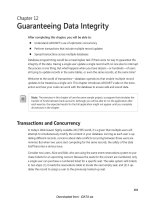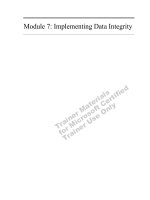Guaranteeing Data Integrity
Bạn đang xem bản rút gọn của tài liệu. Xem và tải ngay bản đầy đủ của tài liệu tại đây (432.11 KB, 19 trang )
191
Chapter 12
Guaranteeing Data Integrity
After completing this chapter, you will be able to:
Understand ADO.NET’s use of optimistic concurrency
Perform transactions that include multiple record updates
Spread transactions across multiple databases
Database programming would be a meaningless task if there were no way to guarantee the
integrity of the data. Having a single user update a single record with no one else to interrupt
the process is one thing. But what happens when you have dozens—or hundreds—of users
all trying to update records in the same tables, or even the same records, at the same time?
Welcome to the world of transactions—database operations that enable multiple record
updates to be treated as a single unit. This chapter introduces ADO.NET’s take on the trans-
action and how your code can work with the database to ensure safe and sound data.
Note
The exercises in this chapter all use the same sample project: a program that simulates the
transfer of funds between bank accounts. Although you will be able to run the application after
each exercise, the expected results for the full application might not appear until you complete
all exercises in the chapter.
Transactions and Concurrency
In today’s Web-based, highly-scalable 24/7/365 world, it’s a given that multiple users will
attempt to simultaneously modify the content in your database. As long as each user is up-
dating different records, concerns about data conflicts occurring between those users are
minimal. But when two users start competing for the same records, the safety of the data
itself becomes a serious issue.
Consider two users, Alice and Bob, who are using the same event reservations system to pur-
chase tickets for an upcoming concert. Because the seats for the concert are numbered, only
a single user can purchase a numbered ticket for a specific seat. The sales system sells tickets
in two steps: (1) it reads the reservations table to locate the next empty seat, and (2) it up-
dates the record to assign a user to the previously looked-up seat.
Dwonloaded from: iDATA.ws
192
Microsoft ADO.NET 4 Step by Step
Figure 12-1 shows three possible scenarios when Alice and Bob use the system at approxi-
mately the same time.
Alice: Read
Scenario #1
Alice: Read
Scenario #2
Alice: Read
Alice: Write Bob: Read Bob: Read
Bob: Read Alice: Write Bob: Write
Bob: Write Bob: Write Alice: Write
Scenario #3
FIGURE 12-1 The risks of multiuser access to data.
Assume that seats 100 and 101 are available and will be reserved in that order. In Scenario
#1, Alice completes her transaction for seat 100 before Bob even begins requesting an open
seat, so there aren’t any data conflicts. But Scenarios #2 and #3 show potential problems.
Depending on how the system is designed, it’s possible that either Bob or Alice will be with-
out a reservation. In Scenario #3, if the system tells both Alice and Bob that 100 is the next
seat available, Alice will get the reservation even through Bob updated the system first. This
“last one wins” situation is a common difficulty to be overcome in database development.
Another potential problem occurs when a database update takes place in multiple parts.
When you transfer money from your savings account to your checking account, the database
records (at least) two distinct updates: (1) the debit of funds from the savings account, and
(2) the credit of those same funds into the checking account. As long as both operations oc-
cur, the record of the transfer is sound. But what happens if the database crashes after the
withdrawal of funds from the savings account, but before those funds make it into the check-
ing account?
Databases attempt to resolve all these conflicts and more by employing transactions. A
transaction is a single unit of database work that is guaranteed to maintain the integrity and
reliability of the data. It does this by adhering to ACID, the four rules that define the transac-
tion, which are as follows:
Atomicity The transaction is all or nothing. If any part of the transaction cannot com-
plete, whether due to invalid data, constraint limitations, or even a hardware failure, the
entire transaction is cancelled and undone. After this reversal completes, the state of
the involved records is the same as if the transaction never occurred.
Dwonloaded from: iDATA.ws
Chapter 12 Guaranteeing Data Integrity
193
Consistency The transaction, when complete, will leave the database in a valid state.
This aspect of transactions often details with constraints. For example, when deleting
a parent record, child records bound by a foreign key constraint must be modified to
remove the parent reference, deleted from the database, or if they remain, the transac-
tion must be canceled.
Isolation This property has to do with multiuser scenarios. When a transaction is
active, other users or processes that attempt to access the involved records are not al-
lowed to see those records in a semicomplete state. The database must either provide
those other processes with the pretransaction content of the records, or force those
processes to block, or wait, until the transaction is complete.
Durability Durable transactions are robust enough to overcome any type of database
failure, and if they are damaged so that they cannot be recovered, they are ultimately
reversed. Modern databases achieve this using transaction logs, a secondary repository
of all database modifications that can be “played back” to recover damaged data if
needed.
Robust databases such as SQL Server ensure that updates made to individual records meet all
these ACID requirements. For updates made to multiple records, especially those that involve
different tables, ACID applies only if you specifically wrap the updates within the database’s
platform-specific implementation of a transaction.
A transaction begins when you specifically tell the database that you need one, and it ends
when you either commit the transaction—making all changes that took place within the
transaction permanent—or issue a rollback—a cancelling or reversal of the entire transaction.
Database systems also employ record locking: the temporary protection of records, record
blocks, or entire tables from use by other processes during the lifetime of a transaction or
other data operation. The isolation property of ACID is a typical record-locking function, al-
though there are other manual and automated actions in which a database will lock records.
Record locking allows programmers to resolve the seat reservation issues previously posed
by Alice and Bob. If Alice locks seat 100 pending completion of the reservation process, Bob
will not have access to that record. Instead, he must either wait until the reservation system
makes a seat number available or reserve a seat that is not currently locked.
Note
Although record locking is a traditional method of protecting records, it is often not ef-
ficient, and sometimes not even possible, when dealing with disconnected, highly-scalable sys-
tems such as busy web sites. Such systems must use other methods of protecting records that
must be restricted to a single user or session. Some of these alternatives are described in this
chapter, on page 194.
Dwonloaded from: iDATA.ws
194
Microsoft ADO.NET 4 Step by Step
Concurrency is the art of when to apply a record lock. There are two main flavors of
concurrency:
Pessimistic concurrency Records destined to be updated are locked when they are
first accessed and read. Only the user holding the lock has full access to the record,
including the ability to modify it. At some point, the record must be released, either
through a formal release of the lock or through an update-and-commit process that
completes the update. Pessimistic concurrency is useful when allowing two users up-
date access to the same record could prove problematic.
Optimistic concurrency Records are left unlocked during the read-write interval and
are locked by the database only at the moment of update. This type of record locking
is good for those times when records are rarely or never accessed by two users at once,
or when the risks associated with having two users update those records in parallel are
small. Limited locks allow for high scalability, although with the increased potential for
data conflicts.
ADO.NET, with its focus on disconnected data processing, uses optimistic concurrency.
Unfortunately, this method leaves some applications open to data conflicts of the type expe-
rienced by Alice and Bob. There are data-specific methods that help avoid, or even eliminate,
these problems, even when pessimistic concurrency is not available. The SqlCommandBuilder
class uses one such method when it builds data modification statements for the target data-
base table. Consider an update statement that modifies several fields in a customer table:
UPDATE Customer SET FullName = @NewName,
Address = @NewAddress, Phone = @NewPhone
WHERE ID = @OriginalID
If User A and User B are both updating the record at the same time, with User A modifying
Address and User B correcting Phone, the “last one wins” rule will apply in the absence of
pessimistic concurrency. SqlCommandBuilder attempts to reduce such issues by including all
the original data values in the update query’s WHERE clause.
UPDATE Customer SET FullName = @NewName,
Address = @NewAddress, Phone = @NewPhone
WHERE ID = @OriginalID
AND FullName = @OriginalName
AND Address = @OriginalAddress
AND Phone = @OriginalPhone
This changes the update system to “first one wins” because any changes made to the record
will fail to match some of the “original” values submitted by the second user—one that still
has the original premodified image of the record—and thus prevent the update request from
Dwonloaded from: iDATA.ws
Chapter 12 Guaranteeing Data Integrity
195
making additional changes without first obtaining the “new original” version of the record. In
SQL Server table updates, a rowversion column can be used in the same way because interim
updates to the record change that column’s value automatically.
/* ----- versiontrack column is of type rowversion. */
UPDATE Customer SET FullName = @NewName,
Address = @NewAddress, Phone = @NewPhone
WHERE ID = @OriginalID
AND versiontrack = @OriginalRowVersion
Note
Some database platforms support statements that let you sidestep ADO.NET’s preference
for optimistic concurrency. The Oracle SELECT statement, for example, includes a FOR UPDATE
clause that applies a persistent lock to the record until it is modified in a subsequent statement
or is otherwise released.
Depending on how you manage your ADO.NET database connections and connection-pooling
options, such SQL statements might provide access to true pessimistic concurrency. If you choose
to use such features, be sure to fully test your implementation, and be aware of changes to ADO.NET
in future releases that might affect your use of such statements.
Using Local Transactions
ADO.NET includes support for transactions with a single database through the System.
Data.Common.DbTransaction class. In the SQL Server provider, this base class is overridden
by the System.Data.SqlClient.SqlTransaction class. The OLE DB and ODBC providers imple-
ment transactions through the System.Data.OleDb.OleDbTransaction and System.Data.
Odbc.OdbcTransaction classes, respectively.
Note
The remaining discussion of transactions focuses on the SQL Server provider’s imple-
mentation. The OLE DB and ODBC implementations are identical, although some of the internal
aspects vary by target database. Some OLE DB or ODBC-accessible databases might not support
transactions.
Using a transaction to enclose multiple update statements is simple:
1. Open a connection to the database with a SqlConnection object.
2. Create a SqlTransaction instance on that connection.
3. Issue SQL statements within the context of the transaction.
4. Either commit or roll back the transaction.
5. Close the database connection.
Dwonloaded from: iDATA.ws
196
Microsoft ADO.NET 4 Step by Step
Instead of creating instances of SqlTransaction directly, you generate connection-specific
transactions using the SqlConnection object’s BeginTransaction method. Transactions work
only on open database connections, so you must call the connection object’s Open method
first.
C#
using (SqlConnection linkToDB = new SqlConnection(connectionString))
{
linkToDB.Open();
SqlTransaction envelope = linkToDB.BeginTransaction();
Visual Basic
Using linkToDB As SqlConnection = New SqlConnection(connectionString)
linkToDB.Open()
Dim envelope As SqlTransaction = linkToDB.BeginTransaction()
After obtaining a transaction object, add it to any SqlCommand objects that should be part
of the transaction.
C#
// ----- Include the transaction in the SqlCommand constructor.
SqlCommand updateCommand = new SqlCommand(sqlText, linkToDB, envelope);
// ----- Or add it to an existing SqlCommand object.
SqlCommand updateCommand = new SqlCommand(sqlText, linkToDB);
updateCommand.Transaction = envelope;
Visual Basic
' ----- Include the transaction in the SqlCommand constructor.
Dim updateCommand As New SqlCommand(sqlText, linkToDB, envelope)
' ----- Or add it to an existing SqlCommand object.
Dim updateCommand As New SqlCommand(sqlText, linkToDB)
updateCommand.Transaction = envelope
After you’ve issued all the transaction-specific commands, you can commit or roll back the
entire transaction by calling the SqlTransaction object’s Commit or Rollback method.
Dwonloaded from: iDATA.ws
Chapter 12 Guaranteeing Data Integrity
197
C#
// ----- Commit the transaction.
envelope.Commit();
// ----- Rollback the transaction.
envelope.Rollback();
Visual Basic
' ----- Commit the transaction.
envelope.Commit()
' ----- Rollback the transaction.
envelope.Rollback()
You should always call Commit or Rollback explicitly. If you dispose of the object or allow it
to go out of scope without calling one of these two methods, the transaction will be rolled
back, but at a time determined by the .NET garbage collection system.
Both Commit and Rollback—and the initial BeginTransaction call as well—generate excep-
tions if there is a database or local failure in the transaction. Always surround these calls with
exception handling statements.
C#
try
{
envelope.Commit();
}
catch (Exception ex)
{
MessageBox.Show("Error saving data: " + ex.Message);
try
{
envelope.Rollback();
}
catch (Exception ex2)
{
// ----- Although the rollback generated an error, the
// transaction will still be rolled back by the
// database because it did not get a commit order.
MessageBox.Show("Error undoing the changes: " + ex2.Message);
}
}
Dwonloaded from: iDATA.ws









